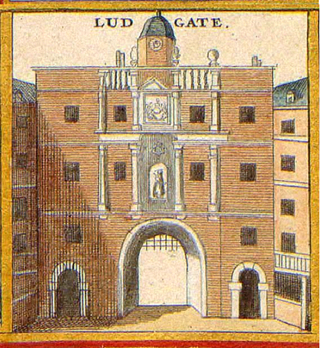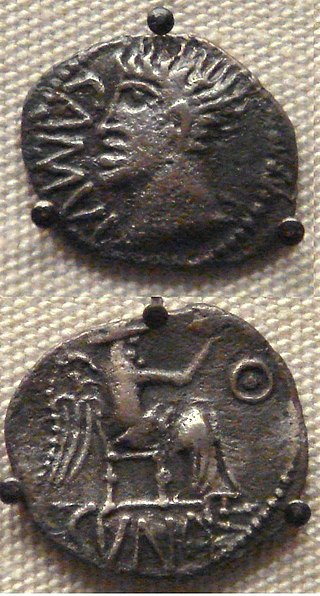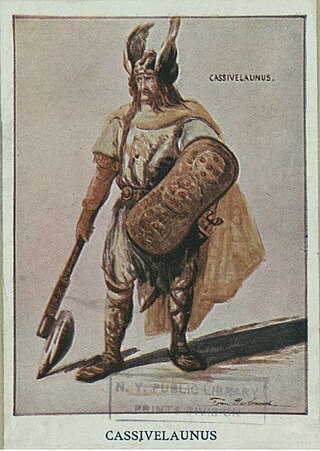
In Irish mythology, Nuada or Nuadu, known by the epithet Airgetlám, was the first king of the Tuatha Dé Danann. He is also called Nechtan, Nuadu Necht and Elcmar, and is the husband of Boann. He is mostly known from the tale in which he loses his arm or hand in battle, and thus his kingship, but regains it after being magically healed by Dian Cécht. Nuada is thought to have been a god and is related to the British and Gaulish god Nodens, who is associated with hunting and fishing. His Welsh equivalent is Nudd or Lludd Llaw Eraint.
Creiddylad, daughter of King Lludd, is a minor character in the early medieval Welsh Arthurian tale Culhwch ac Olwen.
Afallach is a man's name found in several medieval Welsh genealogies, where he is made the son of Beli Mawr. According to a medieval Welsh triad, Afallach was the father of the goddess Modron. The Welsh redactions of Geoffrey of Monmouth's Historia Regum Britanniae, Brut y Brenhinedd, associate him with Ynys Afallach, which is substituted as the Welsh name for Geoffrey's Insula Avalonsis, but this is fanciful medieval etymology and it is more likely his name derives from the Welsh word afall "apple tree" ; from which, granted, the name of Avalon is also often thought to derive, so that the meaning of "Afallach" is associated but not necessarily directly. In the tale of Urien and Modron he is referred to by his daughter as the King of Annwn, therefore he may originally been cognate with Arawn or Gwyn or perhaps all three were once regional variants of the same Deity.

Ludgate was the westernmost gate in London Wall. Of Roman origin, it was rebuilt several times and finally demolished on 30th July 1760. The name survives in Ludgate Hill, an eastward continuation of Fleet Street, Ludgate Circus and Ludgate Square. The gates' materials were sold for £148.

Beli Mawr was an ancestor figure in Middle Welsh literature and genealogies. He is the father of Cassivellaunus, Arianrhod, Lludd Llaw Eraint, Llefelys, and Afallach. In certain medieval genealogies, he is listed as the son or husband of Anna, cousin of Mary, mother of Jesus. According to the Welsh Triads, Beli and Dôn were the parents of Arianrhod, but the mother of Beli's other children—and the father of Dôn's other children—is not mentioned in the medieval Welsh literature. Several royal lines in medieval Wales traced their ancestry to Beli. The Mabinogi names Penarddun as a daughter of Beli Mawr, but the genealogy is confused; it is possible she was meant to be his sister rather than daughter.

Cunobeline or Cunobelin, also known by his name's Latin form Cunobelinus, was a king in pre-Roman Britain from about AD 9 to about AD 40. He is mentioned in passing by the classical historians Suetonius and Dio Cassius, and many coins bearing his inscription have been found. He controlled a substantial portion of south-eastern Britain, including the territories of the Catuvellauni and the Trinovantes, and is called "King of the Britons" by Suetonius. Cunobeline may have been a client king of Rome, based on the images and legends appearing on his coins. Cunobeline appears in British legend as Cynfelyn (Welsh), Kymbelinus or Cymbeline, as in the play by William Shakespeare.

Tasciovanus was a historical king of the Catuvellauni tribe before the Roman conquest of Britain.

Cassivellaunus was a historical British military leader who led the defence against Julius Caesar's second expedition to Britain in 54 BC. He led an alliance of tribes against Roman forces, but eventually surrendered after his location was revealed to Julius Caesar by defeated Britons.
Nennius is a mythical prince of Britain at the time of Julius Caesar's invasions of Britain. His story appears in Geoffrey of Monmouth's History of the Kings of Britain (1136), a work whose contents are now considered largely fictional. In Middle Welsh versions of Geoffrey's Historia he was called Nynniaw.

Historia regum Britanniae, originally called De gestis Britonum, is a fictitious historical account of British history, written around 1136 by Geoffrey of Monmouth. It chronicles the lives of the kings of the Britons over the course of two thousand years, beginning with the Trojans founding the British nation and continuing until the Anglo-Saxons assumed control of much of Britain around the 7th century. It is one of the central pieces of the Matter of Britain.

Welsh mythology consists of both folk traditions developed in Wales, and traditions developed by the Celtic Britons elsewhere before the end of the first millennium. As in most of the predominantly oral societies Celtic mythology and history were recorded orally by specialists such as druids. This oral record has been lost or altered as a result of outside contact and invasion over the years. Much of this altered mythology and history is preserved in medieval Welsh manuscripts, which include the Red Book of Hergest, the White Book of Rhydderch, the Book of Aneirin and the Book of Taliesin. Other works connected to Welsh mythology include the ninth-century Latin historical compilation Historia Brittonum and Geoffrey of Monmouth's twelfth-century Latin chronicle Historia Regum Britanniae, as well as later folklore, such as the materials collected in The Welsh Fairy Book by William Jenkyn Thomas (1908).
Lludd Llaw Ereint son of Beli Mawr, is a legendary hero from Welsh mythology. As Nudd Llaw Ereint he is the father of Gwyn ap Nudd. He is probably the source of king Lud from Geoffrey of Monmouth's History of the Kings of Britain.
Llefelys is a character in Welsh mythology appearing in the medieval Welsh tale Cyfranc Lludd a Llefelys. In the tale, Llefelys is king of Gaul while his brother Lludd is king of Britain. The tale appears in the Red Book of Hergest and the White Book of Rhydderch, the source texts for the Mabinogion, and embedded into various versions of the Brut y Brenhinedd, the Welsh adaptation of Geoffrey of Monmouth's Historia Regum Britanniae.
Gwenddoleu ap Ceidio or Gwenddolau was a Brythonic king who ruled in Arfderydd. This is in what is now south-west Scotland and north-west England in the area around Hadrian's Wall and Carlisle during the sub-Roman period in Britain. Carwinley, near Longtown, north of Carlisle, possibly derives from Cumbric Caer Wenddolau or Gwenddolau's Fort. The earthworks at Liddel Strength is also another contender for Caer Wenddolau.
The Coraniaid are a race of beings from Welsh mythology. They appear in the Middle Welsh prose tale Lludd and Llefelys, which survives in the Mabinogion and inserted into several texts of the Brut y Brenhinedd, a Welsh adaptation of Geoffrey of Monmouth's Historia Regum Britanniae. The Coraniaid figure in the tale as one of three plagues that affect Britain during the reign of King Lludd. They are characterized by a sense of hearing so acute that they can hear any word the wind touches, making action against them impossible.

Brut y Brenhinedd is a collection of variant Middle Welsh versions of Geoffrey of Monmouth's Latin Historia Regum Britanniae. About 60 versions survive, with the earliest dating to the mid-13th century. Adaptations of Geoffrey's Historia were extremely popular throughout Western Europe during the Middle Ages, but the Brut proved especially influential in medieval Wales, where it was largely regarded as an accurate account of the early history of the Celtic Britons.

Lludd and Llefelys is a Middle Welsh prose tale written down in the 12th or 13th century; it was included in the Mabinogion by Lady Charlotte Guest in the 19th century. It tells of the Welsh hero Lludd Llaw Eraint, best known as King Lud son of Heli in Geoffrey of Monmouth's Historia Regum Britanniae, and his brother Llefelys.
Walter of Oxford was a cleric and writer. He served as archdeacon of Oxford in the 12th century. Walter was a friend of Geoffrey of Monmouth, who claimed he got his chief source for the Historia Regum Britanniae from Walter.

The History of the Kings, or Brut y Brenhinedd, is a Welsh translation of Geoffrey of Monmouth’s Historia Regum Britanniae. The manuscript, which was copied in the late fifteenth century, is probably the only illustrated Welsh-language medieval narrative. It is part of the Peniarth Manuscripts collection at the National Library of Wales.











